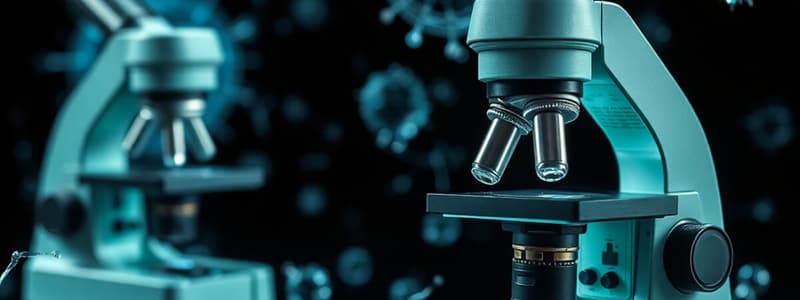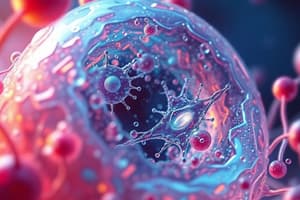Podcast
Questions and Answers
Which type of microscope can examine living cells?
Which type of microscope can examine living cells?
- Compound light microscope (correct)
- Fluorescence microscope
- Scanning tunneling microscope
- Electron microscope
What is the primary function of the cell membrane?
What is the primary function of the cell membrane?
- Photosynthesis
- Energy production
- Genetic information storage
- Cover cell’s surface and act as a barrier (correct)
Which organelle is responsible for the production of ATP during cellular respiration?
Which organelle is responsible for the production of ATP during cellular respiration?
- Mitochondria (correct)
- Golgi apparatus
- Ribosomes
- Chloroplast
What do ribosomes do in a cell?
What do ribosomes do in a cell?
Which of the following structures is uniquely found in animal cells?
Which of the following structures is uniquely found in animal cells?
What is the role of the Golgi apparatus in a cell?
What is the role of the Golgi apparatus in a cell?
Which scientist is known for discovering that all plants are made of cells?
Which scientist is known for discovering that all plants are made of cells?
Which component of the cell membrane is primarily responsible for its selective permeability?
Which component of the cell membrane is primarily responsible for its selective permeability?
Which of the following functions is NOT associated with the cytoskeleton?
Which of the following functions is NOT associated with the cytoskeleton?
Which statement about the smooth endoplasmic reticulum (Smooth ER) is correct?
Which statement about the smooth endoplasmic reticulum (Smooth ER) is correct?
What distinguishes plant cells from animal cells?
What distinguishes plant cells from animal cells?
What role do carbohydrates play in the cell membrane?
What role do carbohydrates play in the cell membrane?
Which organelle is involved in the packaging and distributing of proteins within the cell?
Which organelle is involved in the packaging and distributing of proteins within the cell?
Which structure is responsible for making glucose during photosynthesis?
Which structure is responsible for making glucose during photosynthesis?
Which of the following best describes the function of the nucleus?
Which of the following best describes the function of the nucleus?
Who is credited with the discovery that all cells come from pre-existing cells?
Who is credited with the discovery that all cells come from pre-existing cells?
Flashcards
Compound Light Microscope
Compound Light Microscope
A microscope that uses visible light to magnify specimens, allowing observation of living cells, but with a limited magnification.
Electron Microscope
Electron Microscope
A microscope that uses a beam of electrons to magnify specimens, allowing observation of the very detailed structure of cells and their components at a very high level, but only works on non-living things.
Cell Theory
Cell Theory
The scientific theory that states that all living things are made of cells, cells are the basic unit of structure and function in a living thing, and all cells come from pre-existing cells.
Cell Membrane
Cell Membrane
Signup and view all the flashcards
Cytoskeleton
Cytoskeleton
Signup and view all the flashcards
Mitochondria
Mitochondria
Signup and view all the flashcards
Cell Wall
Cell Wall
Signup and view all the flashcards
Chloroplast
Chloroplast
Signup and view all the flashcards
What is the difference in magnification between a light and an electron microscope?
What is the difference in magnification between a light and an electron microscope?
Signup and view all the flashcards
What are the components of the cell theory?
What are the components of the cell theory?
Signup and view all the flashcards
What are the functions of the cell membrane?
What are the functions of the cell membrane?
Signup and view all the flashcards
What are the key differences between smooth and rough ER?
What are the key differences between smooth and rough ER?
Signup and view all the flashcards
Golgi Apparatus
Golgi Apparatus
Signup and view all the flashcards
What is the function of a lysosome?
What is the function of a lysosome?
Signup and view all the flashcards
What energy is produced by the mitochondria during cellular respiration?
What energy is produced by the mitochondria during cellular respiration?
Signup and view all the flashcards
What are some structures only found in plant cells?
What are some structures only found in plant cells?
Signup and view all the flashcards
Study Notes
Microscopes
- Compound light microscopes can examine living cells but magnify up to only 1000x, insufficient for viewing most organelles.
- Electron microscopes can magnify up to 2,000,000x, allowing examination of nonliving cells and internal/surface cell structures.
Levels of Organization
- The levels of organization, from smallest to largest, are: organelle, cell, tissue, organ, organ system, organism.
Cells
- All living things are made of cells, the basic unit of structure and function.
- All cells originate from pre-existing cells (cell theory).
- Key figures in developing the cell theory:
- Matthias Schleiden (plants are made of cells)
- Theodore Schwann (animals are made of cells)
- Rudolf Virchow (cells come from pre-existing cells)
Cell Membrane
- Also known as the plasma membrane or phospholipid bilayer.
- Function: acts as a barrier between the cell's interior and environment.
- Selectively permeable: controls what enters and leaves the cell.
- Composition: Primarily phospholipids, proteins for transport, and carbohydrates for cell recognition.
Cytoskeleton
- Function: Provides cell shape, movement (e.g., cilia, flagella, pseudopods), and cell division (e.g., centrioles).
Centrioles
- Part of the cytoskeleton involved in cell division.
- Found only in animal cells.
Cytoplasm
- Consists of cytosol (gel-like fluid), cytoskeleton, and organelles.
Nucleus
- Contains DNA (genetic material).
- Controls cell activities.
- Present only in eukaryotic cells.
Ribosomes
- Synthesize proteins.
- Located freely in the cytoplasm or attached to the rough endoplasmic reticulum.
Endoplasmic Reticulum (ER)
- Smooth ER: Lacks ribosomes, synthesizes lipids, detoxifies substances, and transports materials to the Golgi apparatus.
- Rough ER: Contains ribosomes, synthesizes and transports proteins, and transports to the Golgi apparatus.
Golgi Apparatus
- Receives and modifies proteins and lipids from the ER.
- Packages and distributes these molecules to other parts of the cell.
Vacuole
- Membrane-bound space for temporary storage (ions, nutrients, water, waste).
- Plant cells have a large central vacuole for structural support.
Lysosomes
- Membrane-bound pouches containing enzymes to break down waste, food, and invaders.
Mitochondria
- Found in all eukaryotic cells.
- Produces usable energy (ATP) via cellular respiration.
Chloroplast
- Found in plants and some protists.
- Conducts photosynthesis (converts light energy to glucose).
Cell Wall
- Found in plants, fungi, and some protists.
- Rigid structure outside the cell membrane for support and protection.
Extracellular Matrix (ECM)
- Found in animals.
- Function: Support, adhesion, movement, regulation.
Structures Unique to Cell Types
- Animal cells: Lysosomes, centrioles, cilia, flagella
- Plant cells: Cell wall, chloroplasts, large central vacuole.
Studying That Suits You
Use AI to generate personalized quizzes and flashcards to suit your learning preferences.




